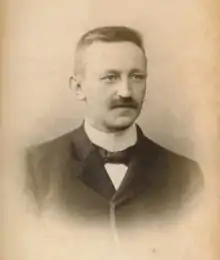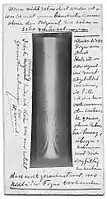Cornelis Wind | |
|---|---|
 | |
| Born | 7 November 1867 Groningen, Netherlands |
| Died | 7 August 1911 (aged 23) Utrecht, Netherlands |
| Scientific career | |
| Fields | Mathematics |
| Institutions | University of Groningen |
Cornelis Wind (7 November 1867 – 7 August 1911) was a Dutch physicist.[1] Wind was a pioneer in X-ray research. He died of bone marrow damage in 1911.
Career
Wind obtained his PhD in 1894 at the University of Groningen.[2] Between 1895 and 1902 he was a lecturer in physical chemistry and mathematical physics at the University of Groningen. Wind was appointed chief director of the Royal Dutch Meteorological Institute (in Dutch: Koninklijk Nederlands Meteorologisch Instituut) in 1902. After his appointment in 1905 as a professor at the Utrecht University in mathematical physics and theoretical mechanics, he remained in different positions at the KNMI until his death in 1911. During his brief life he has initiated important developments in the fields of weather and climate science, earthquake research and research of the sea.
Research
Wind previously showed the electromagnetic character of X-rays and determined their wavelength by diffraction.[3] In their Nobel Prize lectures, both Compton and Von Laue referred to the work of Haga and Wind from 1899.[4] In July 1911, he applied for and resigned as a member of the supervisory committee of the National Institute for the Exploration of the Sea and as a delegate of the Netherlands from the Permanent International Council for the Exploration of the Sea, based in Copenhagen.
 Diffraction door C. H. Wind[5]
Diffraction door C. H. Wind[5]
References
- ↑ 'Cornelis Harm Wind' In: A. de Knecht-van Eekelen, J. F. Panhuysen en G. Rosenbusch, "Door het menschelijke vleesch heen, 100 jaar radiodiagnostiek in Nederland, 1895-1995". (Rotterdam: Erasmus Publishing, 1995) 313-315.
- ↑ "The Mathematics Genealogy Project - Cornelis Wind".
- ↑ H. Haga, C. H. Wind (1899). "De buiging der Röntgenstralen". Versl. Van de Koninklijke Nederlandse Academie van Wetenschappen. 7: 500–507.
- ↑ Röntgen gaf in 1901 geen Nobelprijslezing, maar hij zou vrijwel zeker hebben verwezen naar het werk van Haga en Wind.
- ↑ CC ("Kees") Groothoff, een kleinzoon van CH Wind, bezit de oorspronkelijke 8x2 cm afdruk van een diffractiepatroon dat Wind in 1899 gebruikt om de golflengte van röntgenstralen te bepalen. Hij stuurde deze afbeelding naar Röntgen, die het terugzond met zijn commentaar geschreven in de marge: Wenn nicht retouchiert worden ist — was ich nicht genau beurteilen kann ohne den Original zu sehen — sehr schön gelungen. etc.